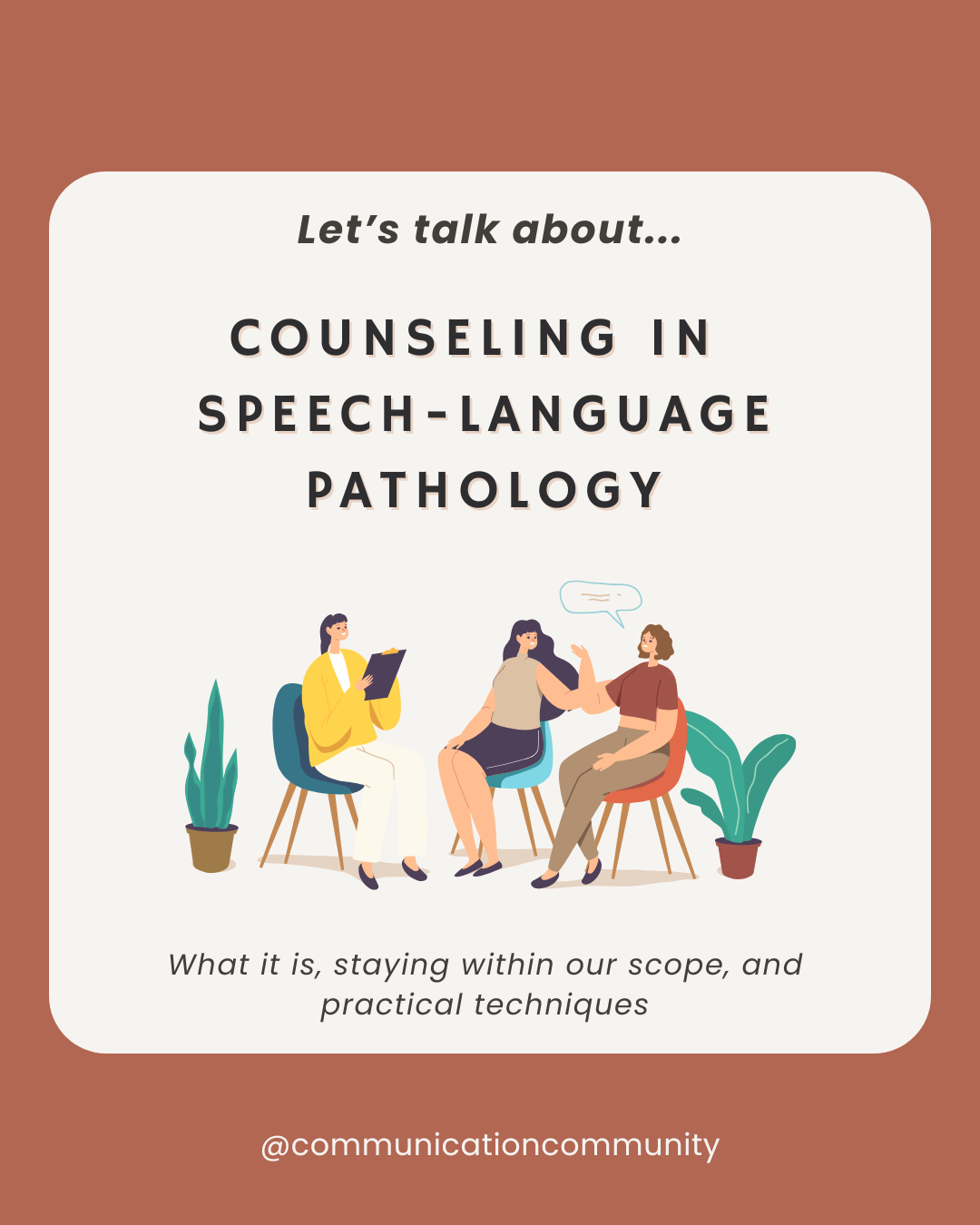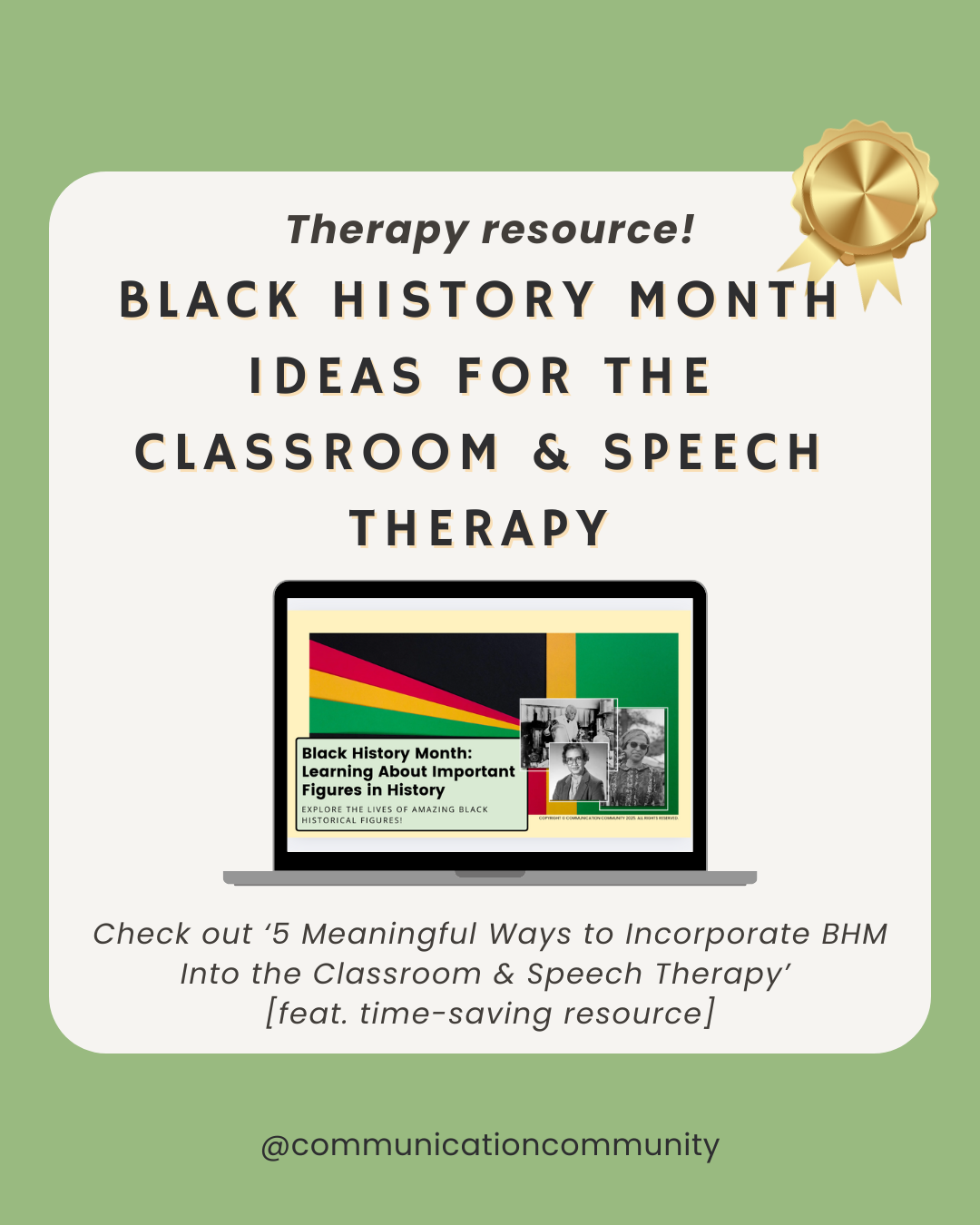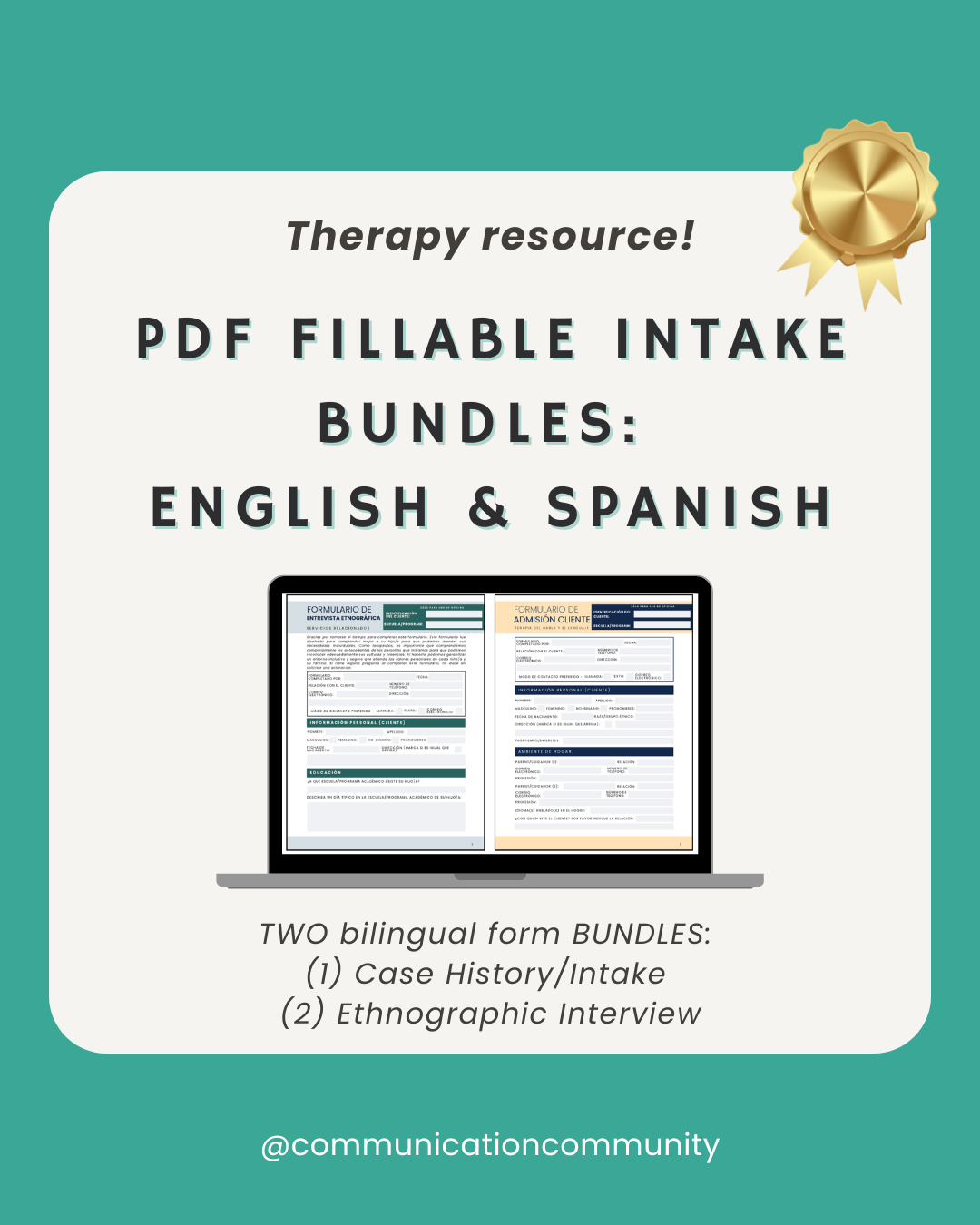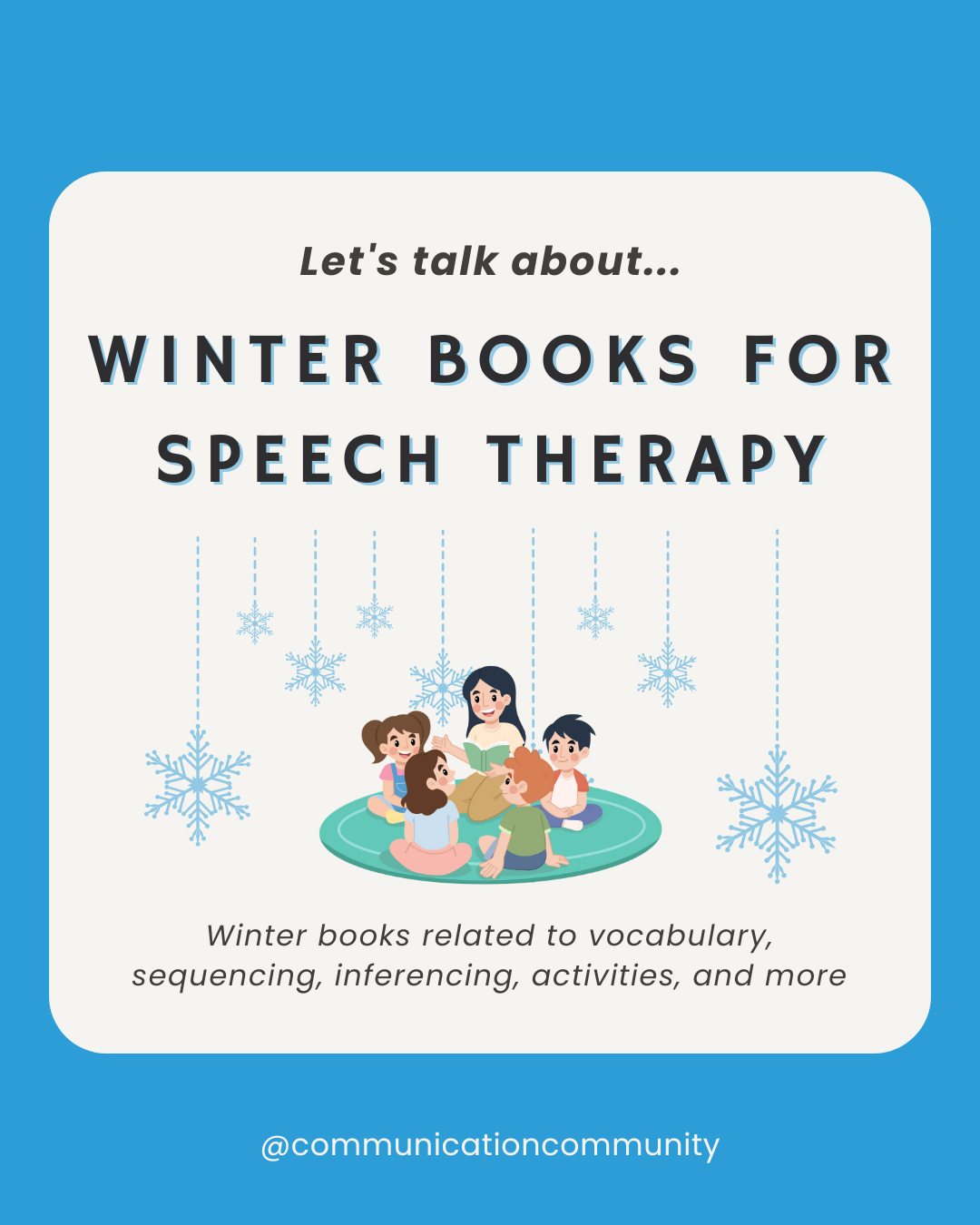What is Neurodiversity?
The concept of neurodiversity acknowledges that brain differences are natural and that conditions like autism, ADHD, or stuttering are variations of the human brain, not deficits.
This concept is crucial to recognize in our field, as many speech-language pathologists (SLPs) treat individuals who identify as neurodivergent and are also the ones who provide support to their caregivers/families.
More recently, many SLPs have deliberately made the "switch" to a neurodiversity-affirming approach, which obviously includes goal writing! Part of implementing this approach involves educating oneself on the meaning and scope of neurodivergence and the experiences of neurodivergent individuals.
A message for clinicians who are exploring this approach for the first time: If you are unfamiliar with neurodiversity-affirming principles, that is okay! Changing a method of therapy that you’ve been accustomed to and formally educated on can take time and understanding. Many, if not all of us have been there. The important thing is that you are here and that you are interested in learning more to better your practice and increase your connection with your clients. Here, you can read more about what it means to be a neurodiversity-affirming therapist!

⭐ Looking for more neurodiversity-affirming resources and support?
In our Premium Community, access over $1000 worth of digital therapy resources (including a designated neurodiversity-affirming resource space), research summaries, and community forums.

Tips for Writing Neurodiversity-Affirming Speech Therapy Goals
In the world of speech therapy, adopting a neurodiversity-affirming approach is not just a method but a philosophy that respects and values the differences in how individuals communicate and perceive the world. Therefore, it is important to remember that there isn’t a ‘set’ rule of thumb as to how neurodiversity-affirming goals should be written, but more of a general guideline of principles to consider when you sit down to write your goals. These principles focus on ways to look through a lens that highlights our client’s differences as strengths versus acknowledging these differences as disorders that need to be fixed.
Considerations when writing neurodiversity-affirming goals:
Goals should be…
Personalized to the individual
- Goals should focus on what is most meaningful and useful to the individual (this translates to: target what is most functional, and/or skill areas the client expresses interest in working on). For instance, how can you write a goal for a client who expresses an interest in better understanding social cues so they can feel more comfortable knowing when to exit a conversation? Perhaps try one that involves learning to make environmental inferences. Why? For one, it is a functional skill that can be applied across contexts and secondly, this may also support the client’s understanding of the different variations of body language/phrases that are consistent with leaving an interaction.
Empowerment-focused versus "normalizing":
- Goals should refrain from pushing neurodivergent clients to conform to "typical" speech patterns and focus on empowering them to communicate in ways that are most effective for them. For example, a client who has had limited success with therapy goals that solely focus on communicating via oral language (verbally), may benefit from exploring augmentative and alternative communication (AAC), such as a speech-generating device. This client may have an increased quality of communication and effectiveness when using other communication modalities that are more suitable for their needs.
Inclusive and collaborative:
- Whenever possible, involve the client and/or their families in the development of their goals/treatment plan! This collaboration can contribute to a sense of assurance with a focus on goals that are aligned with the client’s individualized aspirations and needs. The role of the client and family ensures that the plan is individualized, goal-oriented, culturally and contextually relevant and that it empowers the client within their unique communication journey. We like to use our PDF fillable ethnographic interview to help obtain some of this personal information about our clients' home lives and routines.
Flexible and adaptable (if needed):
- Goals should be worded/sequenced in a way that recognizes that needs and preferences can change over time. Therefore, goals should balance between being adaptable while also recognizing that future goals may go in a different direction. In addition to goals being adaptable, we as clinicians should also be adaptable! For example, you may have a client who has an interest relating to baking; however, you’ve received input from his family that this interest has recently decreased. Rather than writing the client’s goal to say, [Name] will notify an adult by stating/pointing to an unexpected problem/unexpected event, within a kitchen/food prep setting, in 4 out of 5 opportunities, you may want to consider making it more adaptable to other contexts/settings. You could try something like, [Name] will notify an adult by stating/pointing to an unexpected problem/unexpected event, within a natural home setting (e.g., kitchen, living room, bedroom, etc.), in 4 out of 5 opportunities.
Writing Neurodiversity-Affirming Goals
In this article, we focus on writing speech therapy goals that are consistent with a neurodiversity-affirming approach. Below we have provided goals that reflect a traditional (sometimes referred to as ableist) approach to treatment, followed by those that are neurodiversity-affirming. First, we will dive into how these goals can be structured:
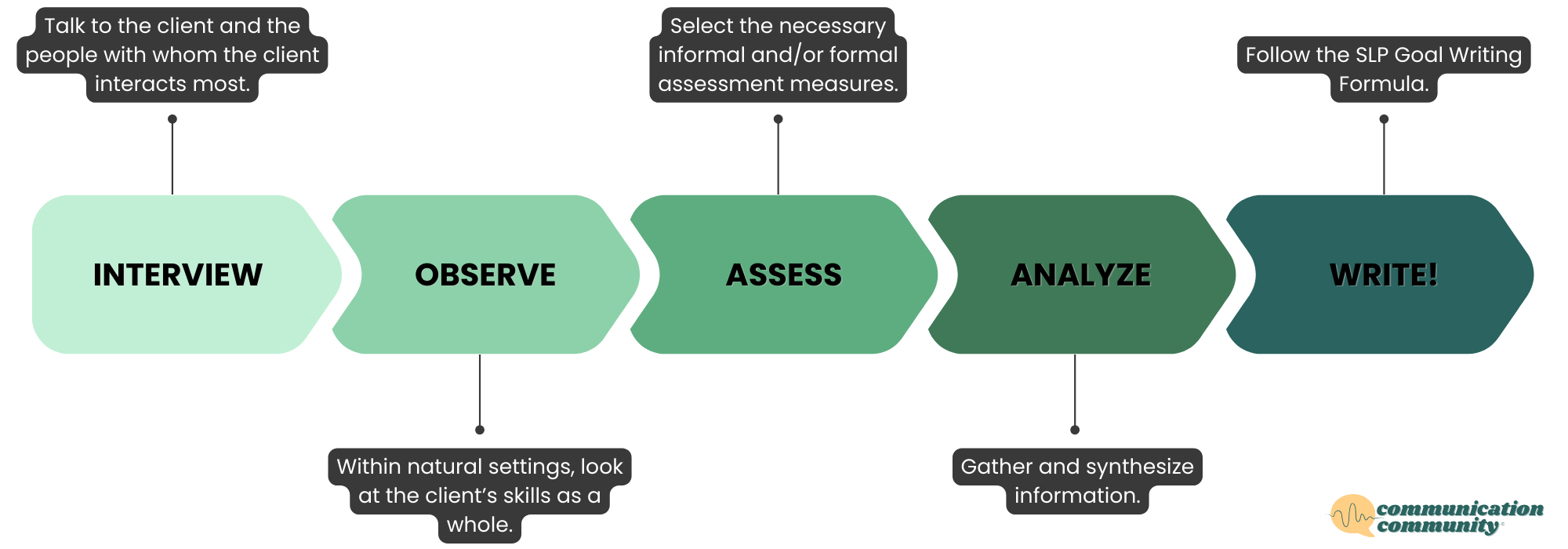
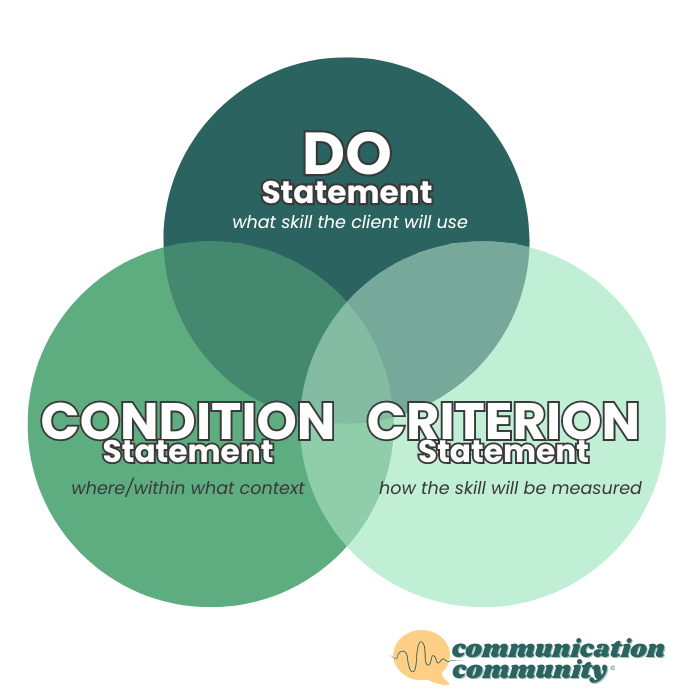
As seen above, speech goals should be written with 3* components in mind: the DO statement, the CONDITION statement, and the CRITERION statement.
*Also commonly included is consistency (we incorporate this!). Aka does the individual have to meet a specific criterion more than once? A common example of this may include across 3 consecutive sessions. This is usually something understood by the therapy organization/service provider and is sometimes/sometimes not included in the written goal itself. This is to ensure that the skill has been generalized and provides more reliable data that the skill has been properly mastered.
DO Statement
What the client is actually going to DO and the specific skill they will be working towards.
Example: will request additional information related to a subject area of interest
CONDITION Statement
The specific setting and/or context your client will work on this skill.
Example: within different academic environments (e.g., classroom setting)
CRITERION Statement
How the client’s performance will be measured.
Example: in 80% of opportunities
DO + CONDITION + CRITERION
Complete example: [Client] will request for additional information related to a subject area of interest, within varied academic environments (e.g., classroom setting), in 80% of opportunities.
There you have it! An example using our Goal Writing Formula containing the DO + CONDITION + CRITERION (don’t forget to think about consistency!) for writing neurodiversity-affirming goals.
Neurodiversity-Affirming Speech Therapy Goal Bank
Below, check out some of our neurodiversity-affirming goals for various areas of treatment. They include what a traditional approach to writing the goal may look like, followed by neurodiversity-affirming examples.
Perspective Taking
Traditional Approach: Teach standard ways of interpreting social situations and only consider the perspectives of others.
Neurodiversity-Affirming: Speech Therapy Goal Example 1
[Client] will identify their opinion about a particular subject/topic, when asked their perspective and when provided with a visual support, in 8 out of 10 opportunities.
Neurodiversity-Affirming: Speech Therapy Goal Example 2
[Client] will state their perspective related to a particular subject/topic, then state the (suspected) perspective of their communication partner, following a group conversation activity, in 4 out of 5 opportunities.
Body Autonomy (AAC)
Traditional Approach: The clinician uses an AAC prompting hierarchy that involves hand-over-hand prompts to target/achieve a communication goal.
Neurodiversity-Affirming: Speech Therapy Goal Example 1
[Client] will use a multimodal communication approach to express information about a preferred topic/interest, within varied contexts and settings, in 90% of opportunities.
Neurodiversity-Affirming: Speech Therapy Goal Example 2
[Client] will use the phrase “I need help,” to request assistance, following a clinician’s model, during routine tasks/activities, in 80% of opportunities.
Problem-Solving
Traditional Approach: Incorporates “problem” targets that are solely focused on ableist perspectives (e.g., Teaching that not having friends and/or eating lunch alone is considered a problem needing a solution).
Neurodiversity-Affirming: Speech Therapy Goal Example 1
[Client] will identify problems related to community safety, when presented with real picture scenes, in 8 out of 10 trials.
Neurodiversity-Affirming: Speech Therapy Goal Example 2
[Client] will state the cause of a functional problem, then state 1-2 preventative techniques, during therapy tasks, with 90% accuracy.
Self-Regulation
Traditional Approach: Teach outdated self-regulation techniques (e.g., eliminate stimming behaviors), irrespective of individual sensory preferences.
Neurodiversity-Affirming: Speech Therapy Goal Example 1
[Client] will identify (e.g., point to) settings where they feel most comfortable, when presented with a visual, in 75% of opportunities.
Neurodiversity-Affirming: Speech Therapy Goal Example 2
[Client] will state how they are feeling and if there is anything they need (e.g., “I feel anxious. I need my fidget.”), during a feeling scan activity or spontaneously, in 4 out of 5 of opportunities.
Self-Advocacy
Traditional Approach: Focus on adapting the individual to existing environments without necessarily advocating for personal needs or changes.
Neurodiversity-Affirming: Speech Therapy Goal Example 1
[Client] will request an accommodation related to work/school, within familiar settings (e.g., internship), in 80% of opportunities.
Neurodiversity-Affirming: Speech Therapy Goal Example 2
[Client] will state if she did not understand her communication partner’s message and request for clarification/repetition/ rephrasing, within conversational interactions, in 90% of opportunities.
Self-Awareness
Traditional Approach: Aim to increase awareness of how one's actions are perceived only according to neurotypical standards and expectations.
Neurodiversity-Affirming: Speech Therapy Goal Example 1
[Client] will state foods that they like, dislike, or have an allergy/food sensitivity to, when presented with menu options, across structured/unstructured settings, in 90% of opportunities.
Neurodiversity-Affirming: Speech Therapy Goal Example 2
[Client] will identify academic areas that they would like to improve or access more information about, during college preparation tasks, 4 times per treatment quarter.
Stuttering
Traditional Approach: Concentrate primarily on achieving fluent speech.
Neurodiversity-Affirming: Speech Therapy Goal Example 1
[Client] will research stuttering support channels (e.g., Instagram accounts of people who stutter [PWS]) and indicate if they are helpful/not helpful, within a clinical setting or as a home task, 5 times during the treatment period.
Neurodiversity-Affirming: Speech Therapy Goal Example 2
[Client] will complete a self-reflection about his stuttering experience across the week, within his home or educational setting, at least 1 time each week.
Social Communication
Traditional Approach: Only introduce neurotypical social communication norms and "appropriate" behaviors.
Neurodiversity-Affirming: Speech Therapy Goal Example 1
[Client] will introduce a conversational topic surrounding a shared interest between him and his communication partner, during various social interactions, in 4 out of 5 opportunities.
Neurodiversity-Affirming: Speech Therapy Goal Example 2
[Client] will describe a personal special interest to an unfamiliar/familiar communication partner, within leisure/social settings, with 80% opportunities.
While neurodiversity-affirming approaches are valuable, it's important to recognize that some neurodivergent (or neurotypical) individuals may prefer more traditional methods of therapy instruction or communication. For example, you may have a client who stutters and would prefer to work on increasing fluency. Every individual is unique, and what works best and is preferred by one person may not be the same for another. It's crucial to respect these preferences and tailor approaches accordingly. For some, traditional methods might provide a sense of structure or familiarity that is comforting or more effective in meeting their specific needs. Ultimately, the choice of therapy method should be guided by the individual's personal comfort, needs, and preferences, ensuring that they feel supported and empowered in their journey. A neurodiversity-affirming approach honors just that!
Looking for MORE neurodiversity-affirming goals and resources?
Check out our top-rated ⭐⭐⭐⭐⭐ comprehensive, neurodiversity-affirming Self-Determination Goal Bank, covering the areas of:
- Choice & decision making
- Goal setting
- Problem solving
- Self-advocacy
- Self-awareness
- Self-efficacy
- Self-regulation

This goal content AND over $1000 worth of other time-saving resources are now available in our time, energy, and cost-saving Premium Community!
References/further resources
Burch, J. (2023, November 9). Affirming neurodivergence: no more ‘quiet hands.’ The ASHA LeaderLive. Retrieved November 30, 2023, from https://leader.pubs.asha.org/do/10.1044/leader.MIW.28112023.slp-neurodiverse-treatment.30/full/
Cleveland Clinic. (2022, June 2). Neurodivergent. Retrieved from https://my.clevelandclinic.org/health/symptoms/23154-neurodivergent
Communication Community. (2023, December 1). How to be a neurodiversity-affirming speech therapist? Retrieved from https://www.communicationcommunity.com/how-to-be-a-neurodiversity-affirming-speech-therapist/
Communication Community. (2023, February). Self-Determination and Self-Advocacy Goals and Resources. Retrieved from https://www.communicationcommunity.com/self-determination-and-self-advocacy-goals-and-resources/
Communication Community. (2023, April 21). What is neurodiversity? Retrieved from https://www.communicationcommunity.com/what-is-neurodiversity/
Cross Country. (2023, September). SLP Goals: Neurodiversity-Affirming Speech Therapy. Retrieved from https://www.crosscountry.com/blog/slp-goals-neurodiversity-affirming-speech-therapy?
DeThorne, L., & Searsmith, K. (2020). Autism and neurodiversity: Addressing concerns and offering implications for the school-based speech-language pathologist. Perspectives of the ASHA Special Interest Groups, 6, 1–7. https://doi.org/10.1044/2020_PERSP-20-00188
Dodd, A. (2023, April 19). Neurodiverse applicants are revolutionizing the hiring process. Quartz. Retrieved from https://qz.com/work/1981466/neurodiverse-applicants-are-revolutionizing-the-hiring-process/
Forbes Business Council. (2023, March 7). Why it's important to embrace neurodiversity in the workplace and how to do it effectively. Forbes. Retrieved from https://www.forbes.com/sites/forbesbusinesscouncil/2023/03/07/why-its-important-to-embrace-neurodiversity-in-the-workplace-and-how-to-do-it-effectively/?sh=6417d0eb4669
National Autism Resource and Information Center, & Autistic Self Advocacy Network. (n.d.). A curriculum for self advocates. Retrieved from https://autisticadvocacy.org/wp-content/uploads/2015/02/CurriculumForSelfAdvocates_r7.pdf
Sauers, J. (2023, November). Incorporating neurodiversity-affirming approaches. The Respectful SLP.
Therapist Neurodiversity Collective. (2023, July 17). Reassessing autistic social intelligence: Challenging the status quo of social skills training. Retrieved from https://therapistndc.org/therapy/social-skills-training/
Yu, B., & Sterponi, L. (2022). Toward neurodiversity: How conversation analysis can contribute to a new approach to social communication assessment. Language Speech and Hearing Services in Schools, 54(1), 27–41. https://doi.org/10.1044/2022_LSHSS-22-00041

![How to Write Neurodiversity-Affirming Speech Therapy Goals [with goal bank]](https://www.communicationcommunity.com/content/images/2023/12/How-to-Write-ND-Goals---ghost-cover.png)
